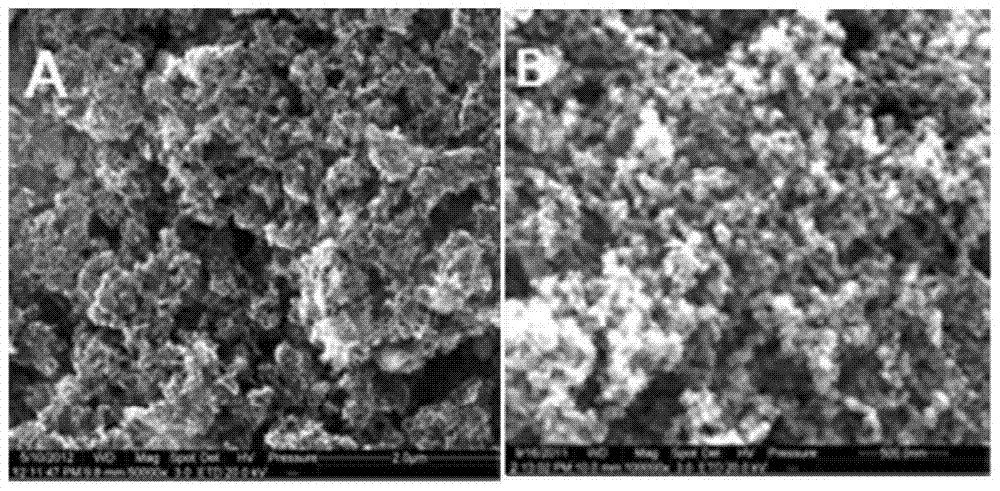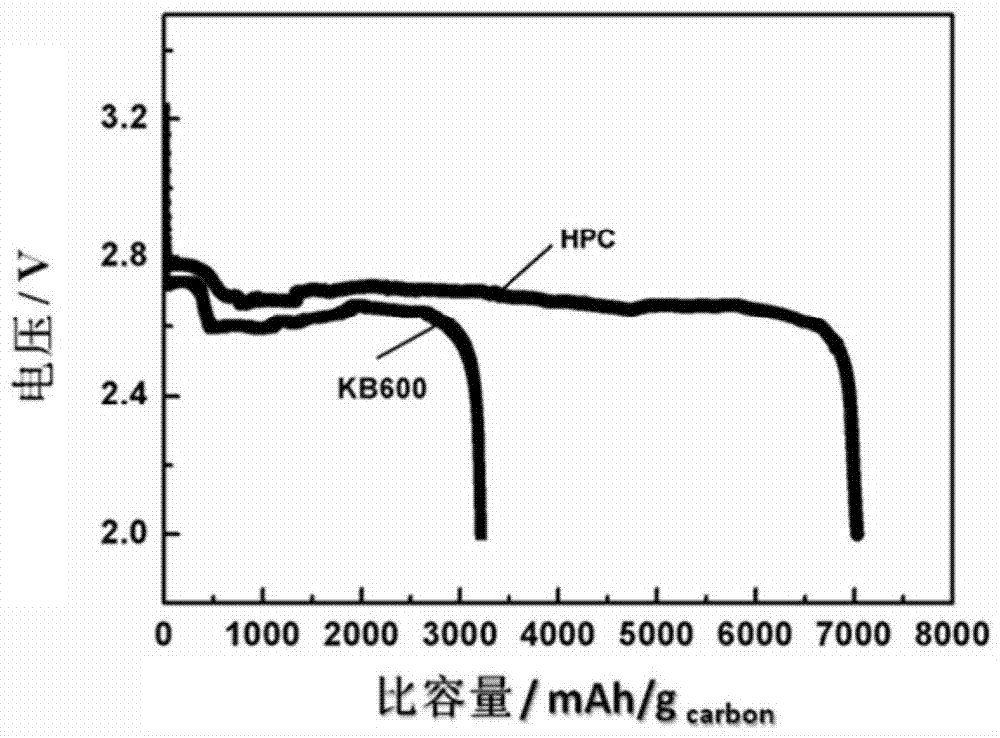A kind of porous carbon material for positive electrode of lithium-air or lithium-oxygen battery
A technology of porous carbon materials and lithium-oxygen batteries, applied in battery electrodes, circuits, electrical components, etc., can solve the problems of unfavorable large-scale commercial preparation and application, failure to meet the requirements of lithium-air batteries, and high experimental conditions. The effects of space utilization, improved energy density and power density, and wide control range
- Summary
- Abstract
- Description
- Claims
- Application Information
AI Technical Summary
Problems solved by technology
Method used
Image
Examples
Embodiment 1
[0043] Hierarchical porous carbon materials were prepared by using nanopowder magnesium carbonate as template combined with catalytic activation method. Accurately weigh 5g of glucose, add 15ml of deionized water and stir until completely dissolved, then add 0.498g of cobalt acetate and 5g of magnesium carbonate, heat and mechanically stir in a water bath at 80°C to make it completely dispersed, and put it in after the water is completely evaporated Dry at 80°C for 24h. Then put the dried product into a high-temperature tube furnace for carbonization, the atmosphere is nitrogen, and the gas flow is controlled at 30ml / min. Take out the nanoparticle / carbon composite by carbonization at 800°C for 3 hours, add an appropriate amount of 2M dilute hydrochloric acid to remove nano-magnesium carbonate and cobalt oxide, and vacuum dry at 80°C for 24 hours after filtration to obtain a porous carbon material with a hierarchical pore structure.
[0044] The structure of the positive elect...
Embodiment 2
[0049] Hierarchical porous carbon materials were prepared using nickel hydroxide powder as a template combined with ammonia gas activation. Accurately weigh 5g of sucrose, add 10ml of deionized water and stir until completely dispersed, then add 10g of nickel hydroxide powder, heat and mechanically stir in a water bath at 80°C to make it completely dispersed, and put it in 80°C after the water is completely evaporated Vacuum dried for 24h. Then put the dried product into a high-temperature tube furnace for carbonization, and treat it in Ar at 800°C for 3h to obtain a nanoparticle / carbon composite, then use an appropriate amount of 2M dilute nitric acid to remove nickel oxide, and vacuum dry it at 80°C for 24h after filtration. The dried product is put into a high-temperature tube furnace and purged with ammonia gas at 800°C for 1 hour to obtain a porous carbon material with a hierarchical pore structure.
Embodiment 3
[0051] Hierarchical porous carbon materials were prepared by using nano-calcium carbonate powder as a template combined with foaming method. Accurately weigh 5g of maltose and 2g of citric acid, add 10ml of deionized water and stir until completely dispersed, then add 10g of calcium carbonate, heat and mechanically stir in a water bath at 80°C to make it completely dispersed, and put it in 60°C after the water is completely evaporated Vacuum dried for 24h. Then put the dried product into a high-temperature tube furnace for carbonization, the atmosphere is nitrogen, and the gas flow is controlled at 20ml / min. After carbonization at 900°C for 2h, the nanoparticle / carbon composite was obtained, and then the nano-calcium carbonate was removed with an appropriate amount of 2M dilute hydrochloric acid, and then vacuum-dried at 80°C for 24h after filtration to obtain a porous carbon material with a hierarchical pore structure.
PUM
| Property | Measurement | Unit |
|---|---|---|
| pore size | aaaaa | aaaaa |
Abstract
Description
Claims
Application Information
 Login to View More
Login to View More - R&D
- Intellectual Property
- Life Sciences
- Materials
- Tech Scout
- Unparalleled Data Quality
- Higher Quality Content
- 60% Fewer Hallucinations
Browse by: Latest US Patents, China's latest patents, Technical Efficacy Thesaurus, Application Domain, Technology Topic, Popular Technical Reports.
© 2025 PatSnap. All rights reserved.Legal|Privacy policy|Modern Slavery Act Transparency Statement|Sitemap|About US| Contact US: help@patsnap.com



